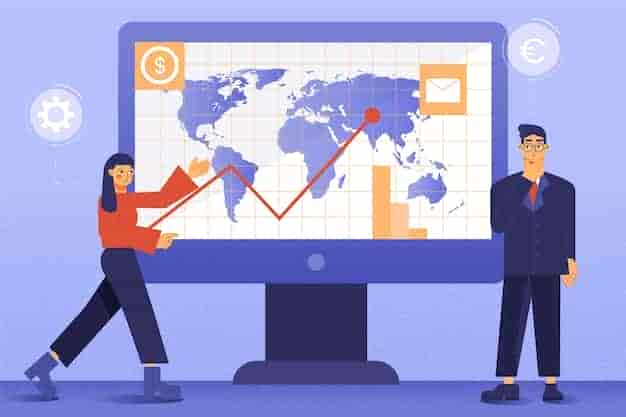Global Market Trends: Key Drivers for Change
Ellie Moore

Photo: Global Market Trends: Key Drivers for Change
In an ever-evolving global economy, understanding market trends is critical for businesses, investors, and policymakers. Global market trends act as a barometer for economic health and a predictor of future developments, influenced by an array of interconnected factors. This article explores the key drivers behind these shifts, providing insights into the dynamics shaping the global marketplace.
The Role of Technology in Shaping Markets
One of the most significant drivers of global market trends is technological innovation. The rise of artificial intelligence (AI), blockchain, and the Internet of Things (IoT) has revolutionized industries ranging from healthcare to finance. These technologies enable greater efficiency, cost reductions, and the creation of entirely new business models.
For instance, AI-powered tools have streamlined supply chain management by predicting demand patterns with remarkable accuracy. Similarly, blockchain technology has redefined data security and transparency, particularly in financial transactions. As these technologies mature, their adoption is expected to accelerate, influencing market dynamics on a global scale.
Geopolitical Factors and Economic Policies
Geopolitics remains a critical influence on global market trends. Trade agreements, tariffs, and sanctions can significantly alter market behavior. For example, tensions between major economies such as the United States and China have led to supply chain disruptions and shifts in manufacturing hubs.
Moreover, economic policies like interest rate adjustments and fiscal stimulus packages play pivotal roles in shaping market conditions. The aftermath of the COVID-19 pandemic saw central banks worldwide adopt expansionary policies, which have had lasting impacts on global markets. Policymakers must strike a delicate balance to ensure sustainable growth while mitigating inflationary pressures.
Sustainability and the Green Economy
Sustainability has transitioned from a niche focus to a cornerstone of market trends. As consumers and investors prioritize environmental, social, and governance (ESG) factors, companies are increasingly aligning their operations with green principles. Renewable energy sources, such as solar and wind, are experiencing unprecedented growth, driven by technological advancements and supportive government policies.
The push for carbon neutrality has also led to innovation in energy storage solutions and electric vehicles (EVs). For instance, Tesla’s dominance in the EV market has inspired traditional automakers to invest heavily in sustainable technologies. This shift is reshaping industries and creating new opportunities for growth.
Demographic Shifts and Consumer Behavior
Changing demographics are another key driver of global market trends. The aging population in developed economies and the rise of the middle class in emerging markets have altered consumption patterns.
In developed countries, older consumers tend to prioritize healthcare and leisure, driving demand in these sectors. Conversely, in emerging markets, the growing middle class is fueling demand for consumer goods, education, and technology. Businesses must adapt their strategies to cater to these evolving needs.
The rise of e-commerce is a notable example of changing consumer behavior. Platforms like Amazon and Alibaba have transformed how people shop, favoring convenience and competitive pricing. As digital adoption grows, particularly in regions like Africa and Southeast Asia, e-commerce is expected to expand further, influencing retail trends globally.
The Impact of Globalization and Regionalization
Globalization has long been a defining characteristic of modern markets, fostering interconnectedness and expanding opportunities. However, recent years have seen a countertrend: regionalization. Factors such as protectionist policies and supply chain vulnerabilities have prompted countries to focus on regional trade agreements and local production.
For example, the Regional Comprehensive Economic Partnership (RCEP) in Asia aims to boost intra-regional trade by reducing tariffs and harmonizing regulations. Similarly, North America’s USMCA agreement reflects efforts to strengthen regional economic ties. These developments signal a nuanced shift in how globalization and regionalization coexist, reshaping global trade dynamics.
Financial Markets and Investment Trends
Financial markets are both a reflection and a driver of global trends. In recent years, the rise of decentralized finance (DeFi) and cryptocurrencies has disrupted traditional investment paradigms. Bitcoin and Ethereum, for example, have challenged conventional assets by offering decentralized alternatives.
Additionally, the pandemic-induced shift to remote work has amplified investments in technology stocks. Companies like Zoom and Microsoft have benefited from the increased reliance on digital tools. Investors are also placing greater emphasis on ESG criteria, steering capital toward companies with sustainable practices.
Challenges and Opportunities Ahead
While these drivers present significant opportunities, they also pose challenges. Rapid technological advancements can lead to job displacement, requiring investments in reskilling and education. Geopolitical tensions may result in economic uncertainties, impacting trade and investment flows.
However, these challenges are accompanied by opportunities for growth and innovation. Businesses that proactively adapt to these trends can gain a competitive edge. For instance, embracing sustainability not only aligns with consumer values but also reduces operational risks in the long term.
Conclusion
Global market trends are shaped by a complex interplay of factors, including technological innovation, geopolitical shifts, sustainability, demographic changes, and evolving financial landscapes. By understanding these drivers, stakeholders can make informed decisions to navigate the uncertainties of a dynamic global market.
As the world continues to face unprecedented changes, staying attuned to these trends is essential for seizing opportunities and mitigating risks. The future of global markets will be defined by those who can anticipate and adapt to the key drivers of change.
Finance & Investment
View All
June 3, 2025
Auto Finance for Used CarsUnlock top rankings and authority with expert SEO content. Discover how E-E-A-T, deep knowledge, and trust are essential for future-proof digital success.
Ellie Moore

April 17, 2025
Ondo Finance and the Future of DeFiUnlock top rankings & authority with expert SEO content. Learn the blueprint to create valuable, E-E-A-T-driven material that stands out.
Ellie Moore

March 9, 2025
Service Finance Company OverviewUnlock authority & top rankings with expert SEO content. Discover how E-E-A-T-driven strategies boost traffic, trust, and conversions.
Ellie Moore

April 3, 2025
Margin Trading for Retail Investors: Pros & ConsDiscover the advantages and risks of margin trading. Learn how retail investors can use leverage effectively without losing big.
Ellie Moore

July 15, 2025
Latest Finance News and Market BuzzDominate search rankings with expert SEO content. Build trust, authority & meet E-E-A-T by delivering high-value, well-researched information to your audience.
Ellie Moore

August 6, 2025
Top Kia Financing Options for 2025Elevate your SEO beyond keywords. Focus on expert content, E-E-A-T, and user intent to build trust, provide value, and rank higher on Google.
Ellie Moore
Insurance
View AllNavigate insurance complexities. This guide helps policyholders, agents & risk managers find top-rated providers for optimal coverage, peace of mind & financial...
Ellie Moore
Unlock the secrets to getting cheap auto insurance fast! Our guide helps you find the best rates and reliable coverage, turning a daunting task into a financial...
Ellie Moore
Don't just insure, secure! This guide reveals why complete home insurance is vital for protecting your home, finances, and peace of mind.
Ellie Moore
Explore how life insurance doubles as an investment tool. Learn about cash value policies and long-term financial benefits.
Ellie Moore
Discover how peer-to-peer insurance models operate, offering community-based risk-sharing alternatives.
Ellie Moore
Protect your small business from cyber threats with essential cyber insurance. Learn why it’s critical in today’s digital age.
Ellie Moore
Education
View AllShould smartphones be allowed in classrooms? Explore the pros and cons of using smartphones in education and their impact on learning.
Read MoreHelp students master metacognition! Learn how teaching students to think about their thinking can improve problem-solving and critical thinking skills.
Read MoreMultilingual education promotes diversity and cultural understanding. Learn why it matters and how it benefits students in a globalized world.
Read MoreExplore how emotional intelligence impacts academic performance. Learn strategies to help students develop emotional skills for better learning outcomes.
Read MoreEthics in education is vital for balanced learning. Learn how to teach morality alongside knowledge transfer in today’s classrooms.
Read MoreDifferent cultures approach early education in unique ways. Discover how cultural values shape learning practices for young children around the world.
Read MorePopular Post 🔥
View All
1
2
3
4
5
6
7
8
9
10
Health






Automotive
View All
July 16, 2025
Explore Exciting Cox Automotive Jobs Opportunities
Drive your career forward with Cox Automotive! Explore diverse job opportunities shaping the future of mobility through innovation and technology.

August 29, 2025
Southeast Automotive Trusted Local Repairs
Navigate auto repairs in the Southeast with confidence! Find trusted local shops for expert care & lasting peace of mind.

February 14, 2025
Biofuels in Cars: Renewable Energy’s Bright Future
Explore the future of renewable energy in automobiles. Learn how biofuels are shaping the next generation of sustainable vehicles.

July 14, 2025
How Automotive Smoke Machines Help Diagnose Cars
Demystify car issues! Automotive smoke machines reveal invisible leaks causing Check Engine lights, rough idle, & poor fuel economy. Save time & money.

August 26, 2025
Kevins Automotive Repair That Goes The Extra Mile
Discover Kevin's Automotive Repair: where trust, transparency, and exceptional service go the extra mile for your vehicle's health and longevity.

September 13, 2025
Main Street Automotive Where Service Matters
Experience car care where service truly matters. Main Street Automotive combines expertise, transparency, & trust for your peace of mind.

















